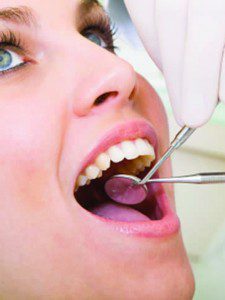By Juan Teodoro, D.M.D. –
 Dentists refer to a dental cleaning appointment as a “dental prophylaxis”. The main purpose of this visit is prevention of dental disease and patient education. This is likely the most important and valuable dental visit a patient may ever make to the dentist. A dental prophylaxis is done on patients that display gum pockets of 3mm or less, no significant gum inflammation and no heavy calculus/plaque under the gum line. A routine dental cleaning typically includes: an oral hygiene evaluation, home care instructions and a demonstration on proper brushing & flossing. Removal of plaque and tartar above the gum level is also done along with a topical fluoride treatment after polishing the teeth. Many hygienists may also review nutrition habits or smoking cessation if warranted.
Dentists refer to a dental cleaning appointment as a “dental prophylaxis”. The main purpose of this visit is prevention of dental disease and patient education. This is likely the most important and valuable dental visit a patient may ever make to the dentist. A dental prophylaxis is done on patients that display gum pockets of 3mm or less, no significant gum inflammation and no heavy calculus/plaque under the gum line. A routine dental cleaning typically includes: an oral hygiene evaluation, home care instructions and a demonstration on proper brushing & flossing. Removal of plaque and tartar above the gum level is also done along with a topical fluoride treatment after polishing the teeth. Many hygienists may also review nutrition habits or smoking cessation if warranted.
Some patients require further gum care if they display signs of periodontal disease. If so, the dentist or hygienist would recommend a comprehensive periodontal evaluation and treatment by a periodontist. A periodontist is a dentist who specializes in the prevention, diagnosis and treatment of periodontal disease and in the placement of dental implants. Periodontists are also dentistry’s experts in the treatment of oral inflammation. They receive extensive training in these areas, including three additional years of education beyond dental school. Periodontists are familiar with the latest techniques for diagnosing and treating periodontal disease. Depending on the patient’s severity of disease, a periodontist may recommend scaling and root planing, gum surgery, regeneration or PerioLase laser therapy.
After a patient has been diagnosed and treated for periodontal disease, a standard cleaning (dental prophylaxis) is no longer appropriate. While a standard cleaning addresses scaling and polishing of the teeth above the gum line, a person who has experienced periodontal disease requires meticulous care below the gum line – a maintenance visit. A periodontal maintenance procedure is not the same treatment as a regular cleaning even though a hygienist may perform both services.
A periodontal maintenance procedure includes:
. An update of your medical and dental history
. X-ray (radiographic) review
. Intraoral and extraoral exam of the cheeks, lips, gums and throat
. Periodontal Probing (around the tooth, gum and bone) an examination done by the periodontist
. Review of home care with demonstration of brushing & flossing
. Removal of Plaque & tartar above & BELOW the gum level (Scaling & Root Planing)
. Polishing & removal of staining
. Gum and pocket irrigation with medicine, as needed
. Topical fluoride application
The typical maintenance interval, especially immediately after active periodontal treatment such as scaling and root planing, surgery, regeneration or PerioLase laser therapy is every three months. This is usually done at the periodontist’s office for the first few visits to make sure the patient is periodontally stable. Once the patient has a good history of stability, then the 3-month maintenance visits start alternating with the general dentist. This allows the periodontist and the general dentist to work as a team in maintaining the patient’s periodontal health.
The recall interval may be lengthened or shortened over time depending on the patient’s history of stability and their effectiveness of home care. The important thing to remember is that once a patient has been diagnosed and treated for periodontal disease they become a periodontal patient for life. Similar to diabetes, there is no cure for periodontal disease. The goal is to prevent recurrence and further progression of the disease, by adhering to a regular maintenance schedule. It has been shown in multiple scientific studies that those patients that do not comply with maintenance visits experience more periodontal/bone degeneration, possible tooth loss and ended up requiring more surgery. Some people tend to have more buildup of calculus than others and some may be more prone to periodontal inflammation or the development of tooth decay. Patients with inadequate oral hygiene practices require more frequent cleanings.
Dr. Teodoro is a Board Certified Periodontist. He holds both Diplomate status in the American Academy of Periodontology and the International Congress of Oral Implantologists. Dr. Teodoro served as a Major in the U.S. Air Force practicing periodontics. Through out his Air Force career he served as Chief of Periodontics, Director of the Implant Board & Clinical Instructor. He is currently a clinical assistant professor at the Naples dental residency program for the University of Florida. Dr. Teodoro is still the only periodontist in both Lee & Collier County trained in Advanced Laser dentistry.
Bonita Periodontics and Implants
239-333-4343
www.bonitaimplants.com








